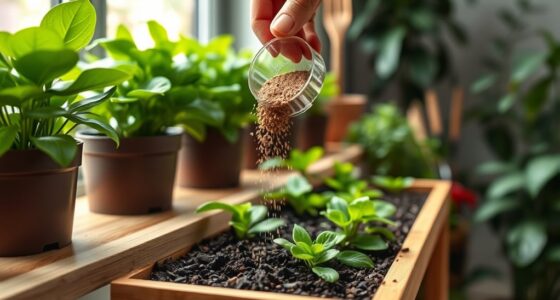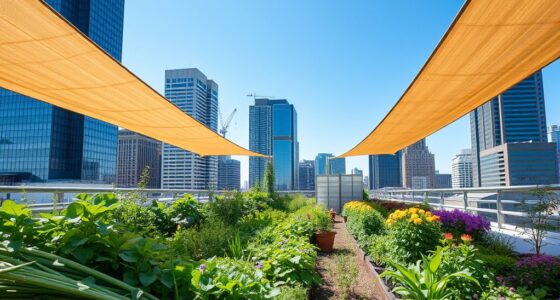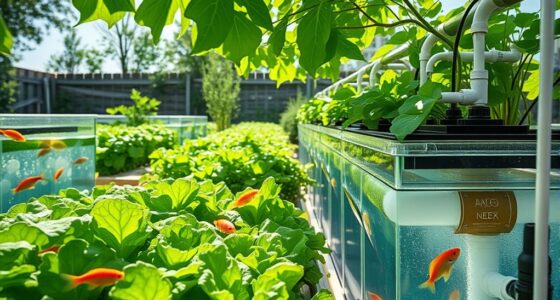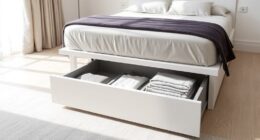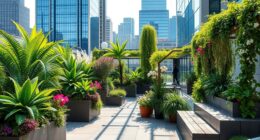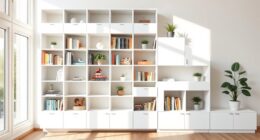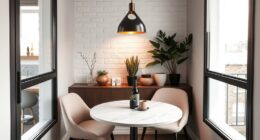In a north-facing apartment, you can still enjoy lush greenery by choosing low-light plants that thrive in shade, like the ZZ Plant, Peace Lily, or Cast Iron Plant. Trailing varieties such as Pothos and Philodendron work well for hanging displays, while tall palms and statement Dracaenas add vertical interest. To keep them healthy, focus on proper watering, indirect light, and occasional artificial lighting. Keep exploring for more tips to create a vibrant, low-maintenance green space that fits your lifestyle.
Key Takeaways
- Choose shade-tolerant plants like ZZ Plant, Cast Iron Plant, and Peace Lily for low-light north-facing rooms.
- Position plants near windows or reflective surfaces to maximize indirect natural light.
- Use artificial LED grow lights for 12-16 hours daily to supplement minimal natural sunlight.
- Opt for low-maintenance, drought-tolerant plants such as Snake Plant and Aspidistra for easy care.
- Incorporate trailing or tall statement plants like Pothos or Dracaena to create focal points in shaded spaces.
Top 7 Houseplants That Thrive in North-Facing Spaces

If your apartment faces north and receives limited sunlight, choosing the right houseplants is essential for creating a lush, vibrant space. North-facing windows cast shaded areas ideal for low-light plants that thrive with minimal plant care.
Resilient plants like the Cast Iron Plant tolerate neglect and need little watering, making them perfect indoor plants for busy schedules. Shade-tolerant options such as the Golden Pothos and ZZ Plant flourish in low indirect light and require low maintenance, thriving in shaded corners.
Peace Lilies add lush foliage and occasional blooms even in darker spots, while the Parlor Palm provides height and texture with moderate watering. Understanding indoor plant care can help you maintain healthy, thriving plants despite limited sunlight. Additionally, selecting plants with adaptations to low-light environments ensures their longevity and health indoors. Recognizing how plant resilience contributes to indoor gardening success can further support your efforts to maintain a thriving indoor jungle. Incorporating low-light plant varieties known for their ability to adapt can make caring for your indoor garden more rewarding and less demanding.
These houseplants are well-suited for low-light environments, transforming your space into a green oasis despite limited sunlight.
Key Factors to Consider When Choosing Low-Light Plants

When selecting low-light plants for your north-facing apartment, understanding the key factors that influence their success can help you make informed choices. Since north-facing windows provide limited direct sunlight, focus on shade-tolerant, low-light plants that thrive in minimal light levels.
Proper plant placement is essential; position plants close to windows or near reflective surfaces to maximize indirect sunlight. Regular plant care, including monitoring for signs of insufficient light like leggy growth or faded leaf color, helps maintain plant health.
If natural light isn’t enough, artificial lighting such as LED grow lights can boost growth and vitality. Choosing plants with slower growth rates and dark green or variegated foliage increases their chances of thriving in these conditions while enhancing your space’s aesthetic.
Recommended Foliage Plants for Shaded Corners

Foliage plants are excellent choices for shaded corners because they thrive in low-light conditions and add vibrant greenery to your space. For shaded corners, consider low light plants like the ZZ plant, with its glossy, dark green leaves that tolerate minimal light and infrequent watering. The cast iron plant (Aspidistra) is another resilient option, thriving in low-light areas with slow growth. The Chinese evergreen offers variegated leaves that brighten dim spaces, while syngonium varieties adapt well as trailing or upright plants. Tall palms like Kentia and Chamaedorea also work well, providing lush greenery without needing direct sunlight. These indoor plants are perfect for creating a thriving, low-maintenance green corner in your apartment. Additionally, selecting diverse designs can enhance your interior aesthetics and create a more inviting atmosphere. To ensure your plants remain healthy, proper watering and maintenance are essential even in low-light conditions.
Easy-Care Low-Light Plants for Busy Homes
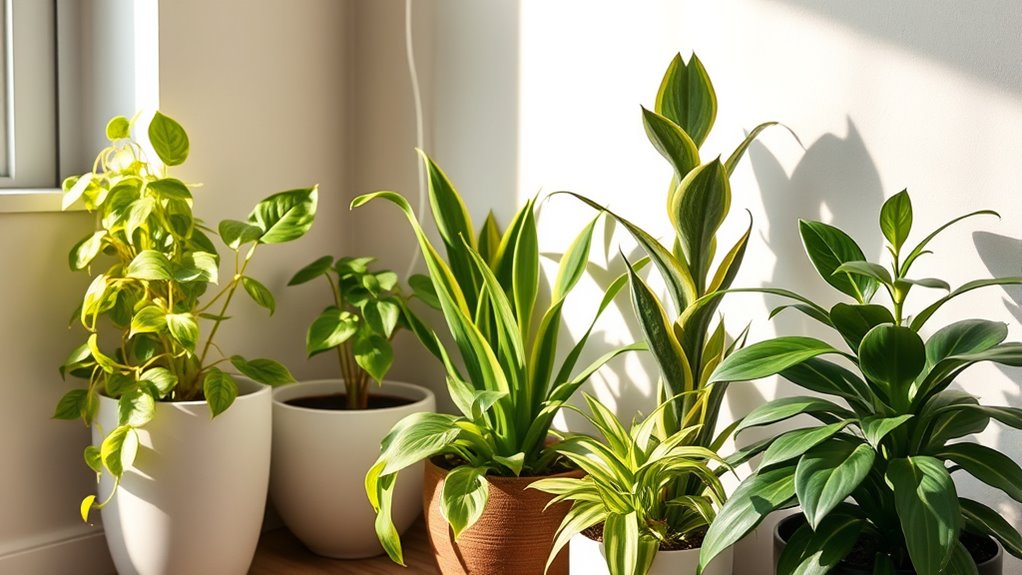
For busy households, choosing low-light plants that require minimal care guarantees your indoor garden stays vibrant without demanding much time. Low-light plants like ZZ Plant, Snake Plant, and Aspidistra thrive in low light, making them perfect for north-facing windows.
These easy-care indoor plants need minimal watering—often only every 2-3 weeks—and are highly resilient, surviving occasional neglect. They’re ideal for indoor gardening in busy homes, as they require low maintenance and can tolerate fluctuating humidity and temperature. Additionally, selecting plants with proven growth habits ensures long-term success in low-light environments.
Incorporating low-maintenance plants with strong adaptability helps maintain a lush appearance without extra effort. Shade-tolerant and adaptable, these resilient plants stay healthy with basic care routines, ensuring your space remains lush and inviting without extra effort. Their ability to thrive in low light makes them the perfect choice for anyone seeking easy-care, low-maintenance greenery.
Stylish Vining and Trailing Plants for North Windows
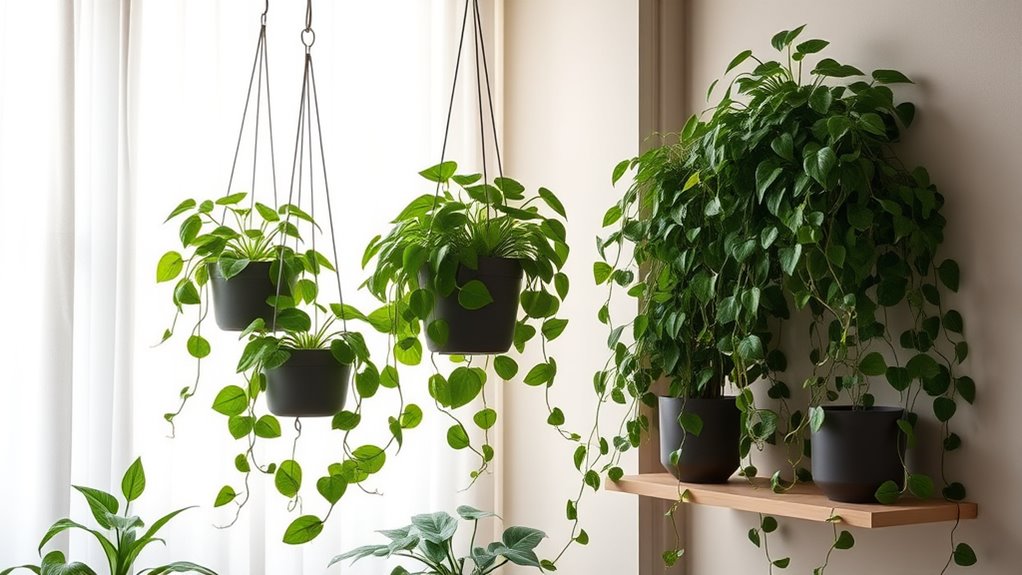
Vining and trailing plants like Pothos and Philodendron are perfect for hanging displays, adding lush greenery to shaded corners. They’re easy to train and grow, making them great for creating stylish, cascading visuals.
With minimal effort, you can transform your north-facing windows into vibrant, eye-catching features.
Perfect for Hanging Displays
Hanging displays are an excellent way to showcase lush greenery in north-facing apartments, especially when you choose plants that thrive in low light. Vining and trailing plants like Heart-leaf Philodendron and Golden Pothos cascade beautifully from hanging baskets or shelves near north-facing windows, adding visual interest.
Swiss Cheese Plant with its unique, holey leaves climbs supports or moss poles, while Spider Plants produce charming baby plantlets, thriving in indirect light. These hanging plants maximize vertical gardening space and create a calming, natural atmosphere.
- Feel the joy of lush greenery flowing freely in shaded spaces
- Enjoy the effortless beauty of low-light trailing plants
- Transform your apartment into a vibrant oasis with minimal effort
Easy to Train and Grow
Many low-light plants like Heart-leaf Philodendron, Golden Pothos, and Swiss Cheese Plant are easy to train along shelves, hooks, or trellises, allowing you to create a stylish, flowing display in your north-facing apartment. These vining and trailing plants adapt well to support structures like moss poles or trellises, promoting natural growth. Propagation is straightforward, so you can expand your vertical greenery over time. Cascading vines like pothos Njoy or Philodendron Brasil add texture and movement, while climbing plants such as Swiss Cheese Vine thrive on support. With minimal light, these low-light plants are perfect for creating a lush, stylish environment where you can easily train and grow them into eye-catching focal points. Incorporating natural materials like wood or stone in your decor can enhance the rustic vibe of your space. Additionally, understanding plant care fundamentals can help ensure your plants stay healthy and vigorous.
Upright and Statement Plants for Dimmer Rooms
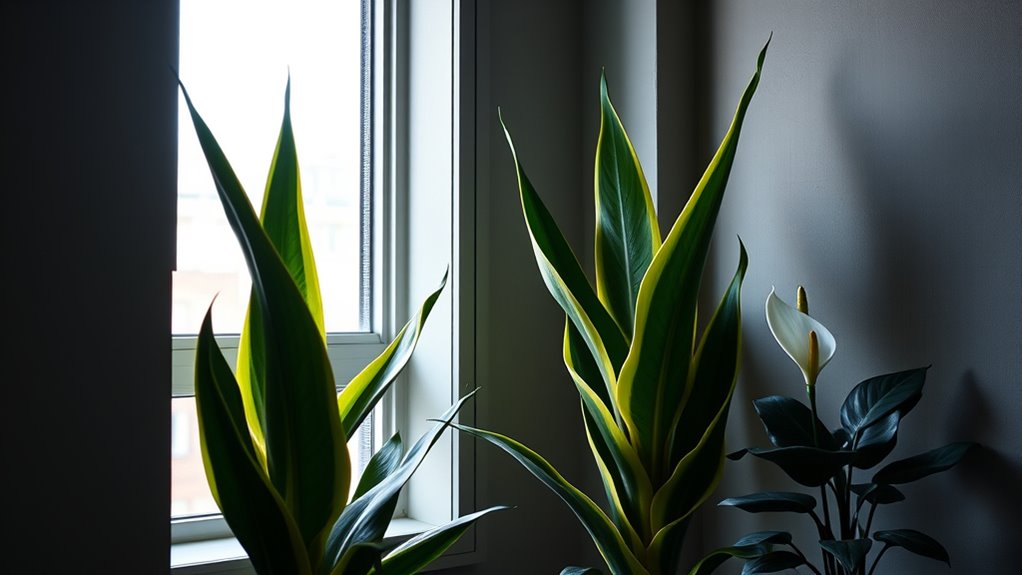
If your north-facing apartment receives limited natural light, incorporating upright and statement plants like the Dracaena marginata and Snake Plant can transform your space. These statement plants thrive in low light and grow vertically, maximizing your room’s height and visual impact. Their architectural foliage adds structure and interest without needing direct sunlight.
Varieties such as the Moonlight Philodendron and Parlor Palm develop slowly but maintain their striking presence, perfect for understated yet eye-catching displays. Many upright plants are hardy, low-maintenance, and tolerant of dimmer rooms, making them ideal for your space.
- Create focal points with tall, vertical growth that elevates your decor
- Add natural statement greenery that boosts mood and style
- Enjoy easy-care, resilient plants that thrive in indirect light
Tips for Caring for Low-Light Indoor Plants
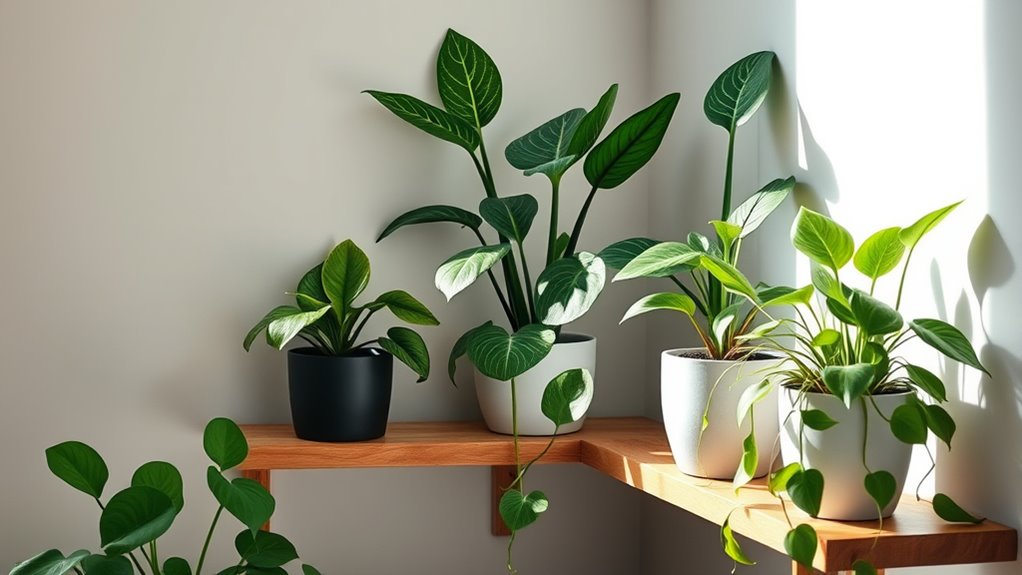
Caring for low-light indoor plants requires paying close attention to watering, as overwatering can quickly lead to root rot. Only water when the top inch of soil feels dry, guaranteeing proper soil moisture. Place your plants near windows or in the brightest spot available to maximize indirect light, or supplement with artificial grow lights for 12-16 hours daily. Use well-draining soil and pots with drainage holes to prevent excess moisture. Regularly dust or wipe leaves to enhance light absorption and promote healthy leaves. Proper plant care ensures your low-light plants thrive, especially when considering self watering plant pots to keep foliage vibrant and healthy. Additionally, understanding AI in Education can help develop innovative tools like intelligent tutoring systems that support personalized learning. Here’s a quick guide:
| Tip | Details |
|---|---|
| Watering | Only when soil is dry, avoid overwatering |
| Light | Maximize natural light or use grow lights |
| Soil | Use well-draining soil with drainage holes |
| Leaf Care | Dust leaves regularly for ideal health, and choosing the right watering method can further promote plant vitality. |
Frequently Asked Questions
What Plant Can I Put in a North-Facing Window?
If you’re wondering what plant to put in a north-facing window, consider one that thrives in low light. You could go with a ZZ Plant or a Peace Lily, as they handle indirect, minimal sunlight well.
Trailing options like Golden Pothos or Philodendron work too. Just place the plant close to the window and add artificial light if needed to keep it healthy and vibrant.
Which Plant Is Best for North Direction?
Imagine a quiet corner bathed in gentle, diffused light from your north-facing window. In this cozy space, the Cast Iron Plant stands tall with glossy, deep green leaves, resilient to shadows. It’s your perfect low-maintenance companion, thriving where others struggle.
With its robust nature, you won’t have to worry about frequent watering or bright sunlight, making it the ideal plant for your north-facing spot.
Can You Have Plants in a North-Facing Room?
Yes, you can have plants in a north-facing room. These spaces offer indirect, subdued light, which suits low-light tolerant plants like Aspidistra, ZZ Plant, or Peace Lily.
Place your plants near the window or add artificial lighting to boost growth. By choosing resilient, shade-loving varieties, you’ll keep your plants healthy and vibrant despite the limited sunlight.
This will help create a lush, inviting space in your apartment.
What Houseplant Needs the Least Amount of Light?
If you’re wondering which houseplant needs the least light, the ZZ Plant is your best choice. It thrives in near-dark conditions and requires minimal watering, making it perfect for low-light spaces.
The Snake Plant and Aspidistra also tolerate very little light, but the ZZ Plant stands out for its resilience and low maintenance. You’ll enjoy lush greenery even in the dimmest corners of your home.
Conclusion
Just like a moonlit night reveals its quiet beauty, your north-facing apartment can become a lush sanctuary. With the right plants, you’ll create a peaceful oasis that breathes life into even the dimmest corners. Remember, every leaf and vine echoes your care—transforming shadows into vibrant, thriving space. Embrace these low-light greens, and watch your home blossom into a haven as serene and enduring as a starry sky.



